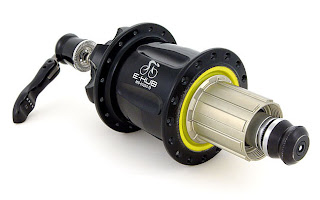 I am still catching up from my vacation last week. It really was great to get away for a few days, play in the ocean with my kids, and totally relax, but I did come back to a LOT of email. I am catching up at work as well, so it might take a while for me to answer all the email I received pertaining to the blog.
I am still catching up from my vacation last week. It really was great to get away for a few days, play in the ocean with my kids, and totally relax, but I did come back to a LOT of email. I am catching up at work as well, so it might take a while for me to answer all the email I received pertaining to the blog.
Tonight though, I want to quickly point out a product that caught my attention today in the September issue of VeloVision magazine. On page 32 they reviewed the E-hub, a rear hub that was designed in Slovenia to even out a rider’s pedal stroke. The E-hub is certainly not the first component that promises to smooth the pedal stroke to order to increase performance, but they are taking a different approach. As the website explains:
“Human muscles are developed for walking and not for circular pedaling. As a result, cyclists experience a “dead spot” of about ±15 degrees around the top and bottom of the pedal path. Several products such as ovoid chain rings that were marketed in the 90s tried to address this problem with poor success or bad side-effects. E-HUB solves this problem once and for all with a unique patented spring mechanism in the hub that overcomes the dead spots while allowing the cyclist to keep her/his usual rhythm.”
While you are at the website, watch the video with pro and elite level riders talking about how the internal spring improves pedaling efficiency resulting in an overall speed increase. I admit to being intrigued by this design, but also a bit skeptical. The VeloVision reviewer did say the effect was noticeable, especially on steep uphills, but in the end he said, “There could be an actual biomechanical improvement, but I’m not 100% convinced it was significant.” That makes me even more skeptical, but I would still love to try the hub for myself.
Regardless of how well it works, I was initially intrigued by the fact that this hub, which basically redistributes pedaling energy to boost performance, is being marketed for racing. They even point out that it is approved by the UCI, which I have a have a hard time believing will remain the case if it really does offer time gains up to 10% as the website claims. So what do you think of a hub that uses an internal coil spring to even out the pedal stroke and better distribute a rider’s pedaling power to the rear wheel? If there is a true biomechanical advantage as claimed, should it be allowed for racing? I have my own opinion, but I am curious what you all think.

Leave a Reply